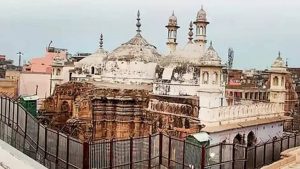Carbon Dating Of a ‘Shivling’ Inside Gyanvapi Mosque : Varanasi

The Allahabad High Court allowed the Archeological Survey of India (ASI) to conduct Carbon Dating of a ‘Shivling’ inside the Gyanvapi Mosque in Varanasi, Uttar Pradesh.
- The petitioners have claimed the object inside the Gyanvapi mosque to be a “Shivling”.
- The claim was disputed by the Muslim side, which said the object was part of a “fountain”.
- It set aside an order of the Varanasi District Court that rejected a plea for scientific investigation, including carbon dating, of the structure.
- Carbon dating is a widely used method to establish the age of organic materials, things that were once living.
- Living things have carbon in them in various forms.
- The dating method is based on the fact that Carbon-14 (C-14) is radioactive, and decays at a well-known rate.
- C-14 is an isotope of carbon with an atomic mass of 14.
- The most abundant isotope of carbon in the atmosphere is C-12.
- A very small amount of C-14 is also present.
- The ratio of C-12 to C-14 in the atmosphere is almost static and is known.




